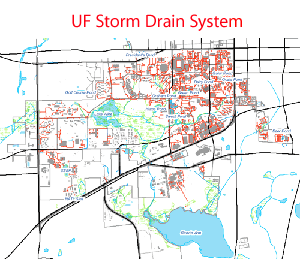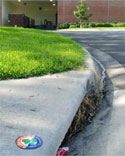Storm Drain System
Did you ever wonder where storm drains go?
A common misconception is that stormwater is treated by wastewater treatment plants. Except in a few older urban areas, this is not the case. Rather, storm drains connect to a system of culverts and pipes which transport stormwater directly to the nearest river, lake, stream or wetland without treatment.
Storm drains were designed to help alleviate potential flooding problems after a rain event by transporting rain water quickly off paved areas. When leaves, sediments, car oil, paints or other materials are improperly disposed into drains, the drains can become clogged and can carry contaminants directly into local waterbodies.
Although each storm drain inlet contributes only a small amount of pollution, collectively, community storm drain pollution can exceed safe levels.
If the pollutants entering each inlet can be reduced, the pollution in local streams and lakes will be reduced as well.
The UF campus has more than 400 storm drains. The map below shows the underground system of pipes (show in red) that connect all drains and direct stormwater to culverts and creeks.
For a more detailed view, please see the UF Campus storm drain PDF map (3MB).
About 77% of these drains eventually direct stormwater to Lake Alice. Some of the area on the west end of campus, including about 17% of the total storm drain inlets, drains to Hogtown Creek. About 4% of the drains lead to Tumblin Creek on the southeast end of campus. About 2% of storm drains lead to internal natural depressions.
To help people understand that these drains transport water – and pollutants – directly to our creeks and lakes, the UF Clean Water Campaign has begun labeling all of the storm drains on campus with special markers, specific to the waterbody to which they drain.




